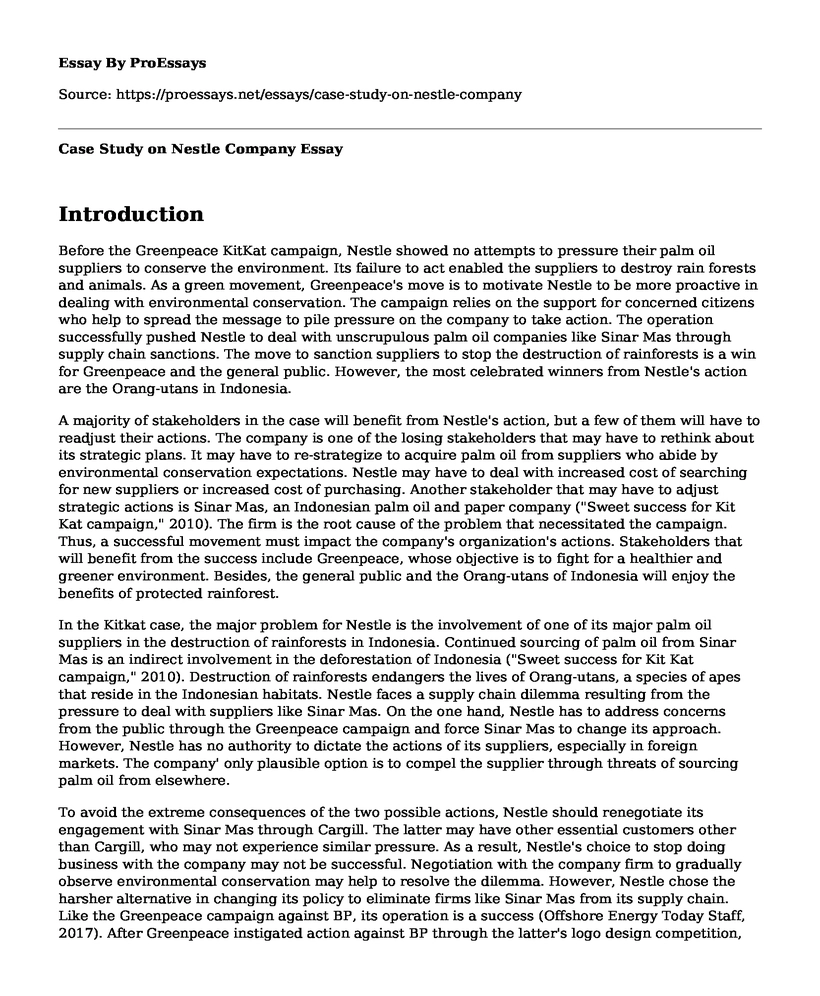Introduction
Before the Greenpeace KitKat campaign, Nestle showed no attempts to pressure their palm oil suppliers to conserve the environment. Its failure to act enabled the suppliers to destroy rain forests and animals. As a green movement, Greenpeace's move is to motivate Nestle to be more proactive in dealing with environmental conservation. The campaign relies on the support for concerned citizens who help to spread the message to pile pressure on the company to take action. The operation successfully pushed Nestle to deal with unscrupulous palm oil companies like Sinar Mas through supply chain sanctions. The move to sanction suppliers to stop the destruction of rainforests is a win for Greenpeace and the general public. However, the most celebrated winners from Nestle's action are the Orang-utans in Indonesia.
A majority of stakeholders in the case will benefit from Nestle's action, but a few of them will have to readjust their actions. The company is one of the losing stakeholders that may have to rethink about its strategic plans. It may have to re-strategize to acquire palm oil from suppliers who abide by environmental conservation expectations. Nestle may have to deal with increased cost of searching for new suppliers or increased cost of purchasing. Another stakeholder that may have to adjust strategic actions is Sinar Mas, an Indonesian palm oil and paper company ("Sweet success for Kit Kat campaign," 2010). The firm is the root cause of the problem that necessitated the campaign. Thus, a successful movement must impact the company's organization's actions. Stakeholders that will benefit from the success include Greenpeace, whose objective is to fight for a healthier and greener environment. Besides, the general public and the Orang-utans of Indonesia will enjoy the benefits of protected rainforest.
In the Kitkat case, the major problem for Nestle is the involvement of one of its major palm oil suppliers in the destruction of rainforests in Indonesia. Continued sourcing of palm oil from Sinar Mas is an indirect involvement in the deforestation of Indonesia ("Sweet success for Kit Kat campaign," 2010). Destruction of rainforests endangers the lives of Orang-utans, a species of apes that reside in the Indonesian habitats. Nestle faces a supply chain dilemma resulting from the pressure to deal with suppliers like Sinar Mas. On the one hand, Nestle has to address concerns from the public through the Greenpeace campaign and force Sinar Mas to change its approach. However, Nestle has no authority to dictate the actions of its suppliers, especially in foreign markets. The company' only plausible option is to compel the supplier through threats of sourcing palm oil from elsewhere.
To avoid the extreme consequences of the two possible actions, Nestle should renegotiate its engagement with Sinar Mas through Cargill. The latter may have other essential customers other than Cargill, who may not experience similar pressure. As a result, Nestle's choice to stop doing business with the company may not be successful. Negotiation with the company firm to gradually observe environmental conservation may help to resolve the dilemma. However, Nestle chose the harsher alternative in changing its policy to eliminate firms like Sinar Mas from its supply chain. Like the Greenpeace campaign against BP, its operation is a success (Offshore Energy Today Staff, 2017). After Greenpeace instigated action against BP through the latter's logo design competition, the company reacted by assuring compliance with environmental protection requirements.
Conclusion
The Nestle case shows commitment from Greenpeace and the public to battle companies that do not observe environmental conservation policies. Greenpeace, with the help of the people, also held a successful campaign against BP. The campaigns' objective is to capture the stakeholder's attention and force them to act. Greenpeace uses social media and other platforms to voice concerns of environmental destruction activities that involve major corporations. The success of the campaigns depends on their appeal to the public and the target company's willingness to act.
References
Offshore Energy Today Staff. (2017). Greenpeace stages protest against BP's offshore drilling plan. Retrieved from offshoreenergytoday.com/greenpeace-stages-protest-against-bps-offshore-drilling-plan/
Sweet success for Kit Kat campaign: You asked, Nestle has answered. (2010). Retrieved from greenpeace.org/archive-international/en/news/features/Sweet-success-for-Kit-Kat-campaign/
Cite this page
Case Study on Nestle Company. (2022, Dec 04). Retrieved from https://proessays.net/essays/case-study-on-nestle-company
If you are the original author of this essay and no longer wish to have it published on the ProEssays website, please click below to request its removal:
- The Business Context Analysis on Example of Apple
- Fundamentals of Drying Processes Paper Example
- An Overview of the Physical Activity Environment Paper Example
- Essay Sample on Amazon and Its Marketing Innovations
- Amazon Supermarkets: Strengthening Customer Trustworthiness & Revenue Growth - Essay Sample
- Walmart's Success & Struggles in International Markets - Essay Sample
- Snow Earth: Cause of Cambrian Explosion? - Essay Sample







